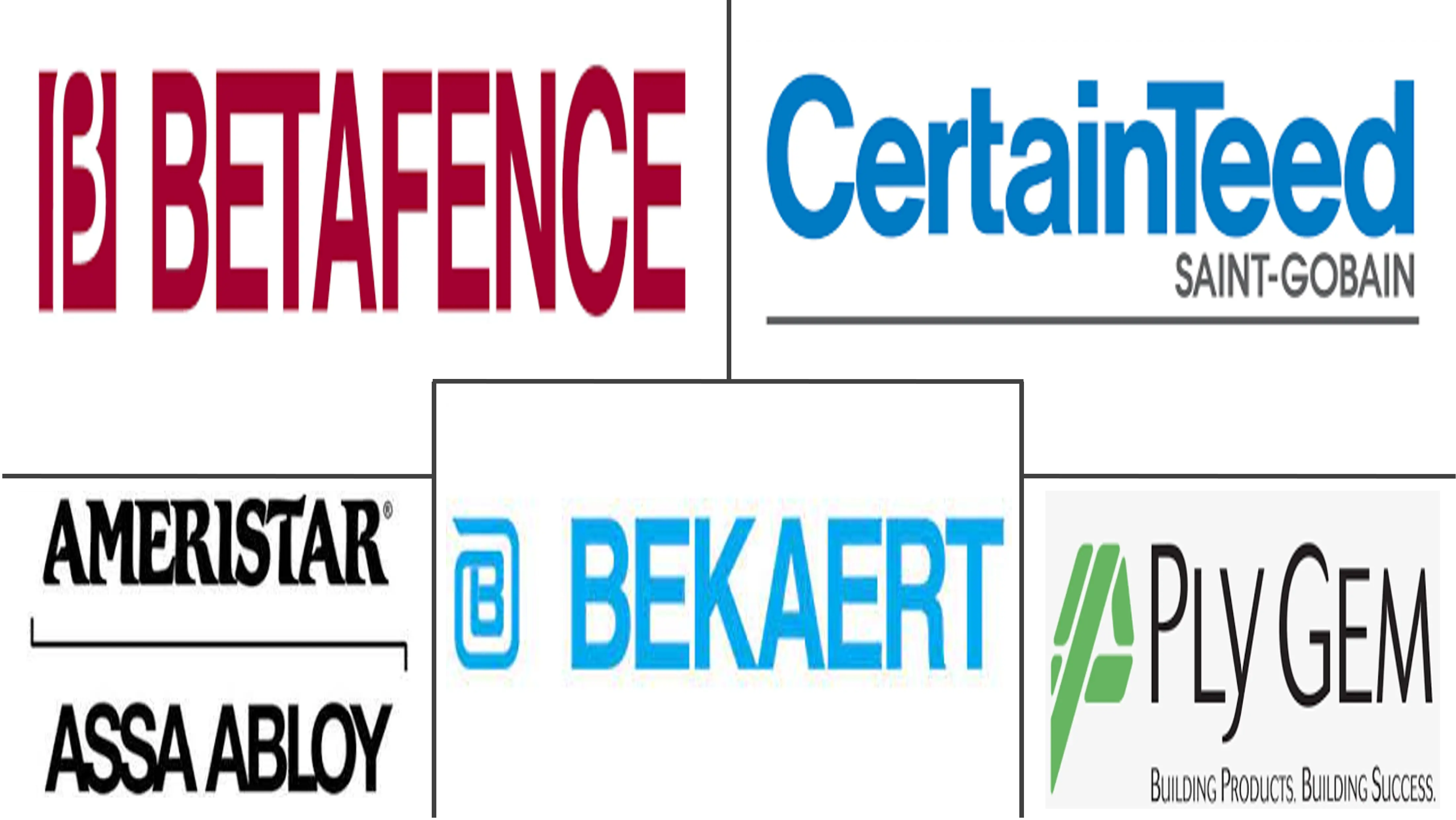Fencing Market Size and Share
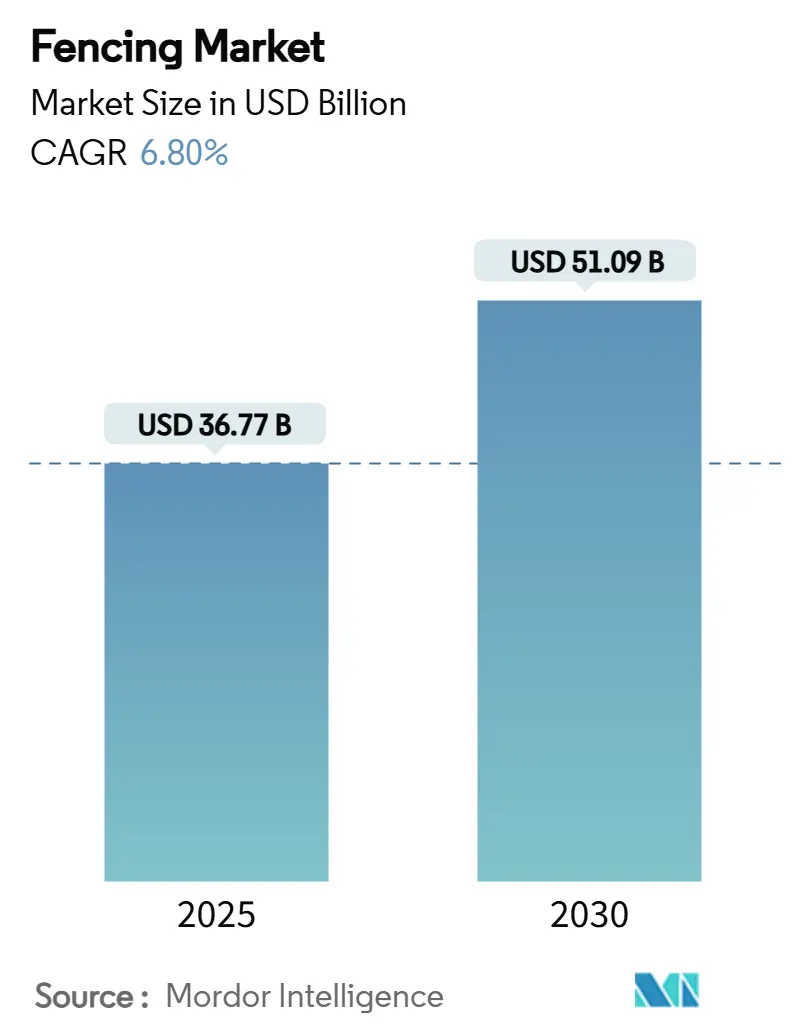
Fencing Market Analysis by Mordor Intelligence
The Fencing Market size is estimated at USD 36.77 billion in 2025, and is expected to reach USD 51.09 billion by 2030, at a CAGR of 6.80% during the forecast period (2025-2030).
This expansion reflects mandatory hardening of power grids, data centers and borders, the rapid commercialization of smart perimeter hardware, and steady government infrastructure outlays. Metal products continue to dominate large‐scale projects because of durability and life-cycle economics, while composite and PVC alternatives are scaling quickly under climate-resilient design mandates. Residential demand remains robust, yet agriculture and renewable-energy installations are emerging as the fastest-moving opportunity set. Professional contractors capture most revenue as IoT‐enabled systems raise the technical bar, although DIY kits are expanding in mature housing markets. Regionally, North America retains leadership because of federal spending packages, but Asia-Pacific is set to outpace all other regions on the back of multibillion-dollar border and industrial programs.
Key Report Takeaways
- By material, metal fencing held 50.53% of the fencing market share in 2024, while plastic and composite materials are projected to grow at an 8.7% CAGR through 2030.
- By end-user, residential applications led with 51.7% revenue share in 2024; agricultural sites are forecast to expand at a 7.8% CAGR to 2030.
- By installation type, professional contractors accounted for 68.43% of the fencing market size in 2024; DIY and modular systems are growing at an 8.02% CAGR through 2030.
- By geography, North America controlled 35.54% of 2024 revenue; Asia-Pacific is advancing at a 7.43% CAGR to 2030.
Global Fencing Market Trends and Insights
Drivers Impact Analysis
| Driver | ( ~ ) % Impact on CAGR Forecast | Geographic Relevance | Impact Timeline |
|---|---|---|---|
| Government infrastructure spend boosting perimeter safety demand | +1.8% | Global, concentrated in APAC & North America | Medium term (2-4 years) |
| Rising adoption of smart, sensor-enabled fencing systems | +1.2% | North America & EU, expanding to APAC | Long term (≥ 4 years) |
| Mandatory critical-asset hardening regulations | +1.1% | North America, EU, expanding globally | Medium term (2-4 years) |
| Climate-resilient composite & PVC materials gaining traction | +0.9% | Global, particularly in extreme-weather regions | Medium term (2-4 years) |
| Surging DIY home-improvement culture | +0.7% | North America, Europe, Australia | Short term (≤ 2 years) |
| Perimeter security for agrivoltaics & vertical farming | +0.6% | Global, early adoption in EU & North America | Long term (≥ 4 years) |
| Source: Mordor Intelligence | |||
Government Infrastructure Spend Boosting Perimeter Safety Demand
National security priorities are translating into sizeable multiyear budgets devoted to border fortifications and critical-asset protection. India has earmarked INR 32,500 crore (USD 3.89 billion) for fencing and road construction along sensitive borders through 2034, specifying anti-cut and anti-climb steel designs. Updated North American Electric Reliability Corporation guidance requires crash-rated gates at high-impact grid control centers, prompting utilities to overhaul outdated perimeter lines[1]North American Electric Reliability Corporation, “Security Guideline for the Electricity Sector,” nerc.com. United States federal building standards now embed Crime Prevention Through Environmental Design principles that specify layered barriers and electronic access control[2]U.S. Department of Veterans Affairs, “Physical Security and Resiliency Design Manual,” va.gov. These mandates are fueling demand for high-specification installations and favoring suppliers with security clearances.
Rising Adoption Of Smart, Sensor-Enabled Fencing Systems
IoT integration is converting passive fences into active threat-detection networks. IEEE studies show multi-sensor smart fences cut false alarms by 60% relative to legacy beam detectors[3]Institute of Electrical and Electronics Engineers, “Low-Cost IoT-Based Smart Fence,” ieee.org. The U.S. Department of Defense telecommunication standard, recently updated to incorporate secure IoT interfaces, is shaping commercial product roadmaps. Airports adhering to National Safe Skies Alliance best practices are now specifying perimeter solutions that merge video analytics, radar, and credential databases. Department of Homeland Security validation protocols have created uniform performance metrics that accelerate procurement cycles.
Mandatory Critical-Asset Hardening Regulations
Perimeter codes originally targeting defense assets now extend to data centers, renewables, and telecom towers. The U.S. General Services Administration prescribes vehicle-impact barriers and electronic access for Facility Security Level III buildings. Utilities performing NERC-mandated threat assessments are rolling out concentric zones that start with reinforced fencing. Integration with building-automation software is enabling subscription-based security-as-a-service offerings, though certification hurdles are consolidating the contractor base in favor of incumbents.
Climate-Resilient Composite & PVC Materials Gaining Traction
Accelerated wear from heat, salt, and wind events is steering specifiers toward lightweight composites and advanced PVC. Novel agrivoltaic fencing proves that dual-use structures can deliver PV racking costs near USD 0.035 per kWh while maintaining livestock containment. EU Regulation 923/2023 caps lead stabilizers in PVC at 0.1% by weight from November 2024, compelling compounders to adopt calcium-zinc systems. The European Chemicals Agency added six new Substances of Very High Concern in January 2025, a move that amplifies compliance costs for legacy formulations. Producers with recycling lines and bio-based additives are thus gaining a share.
Restraints Impact Analysis
| Restraint | % Impact on CAGR Forecast | Geographic Relevance | Impact Timeline |
|---|---|---|---|
| Volatile steel, timber & PVC resin prices | -1.4% | Global, with acute impact in emerging markets | Short term (≤ 2 years) |
| Competition from low-cost unorganised manufacturers | -0.8% | APAC, MEA, with spillover to price-sensitive segments globally | Medium term (2-4 years) |
| Stricter environmental rules on wood preservatives & PVC additives | -0.6% | EU, expanding to North America and developed markets | Medium term (2-4 years) |
| Rising substitute spend on electronic surveillance in lieu of physical barriers | -0.4% | North America & EU, with early adoption in high-security applications | Long term (≥ 4 years) |
| Source: Mordor Intelligence | |||
Volatile Steel, Timber & PVC Resin Prices
Metal and resin markets remain tight due to energy costs and electrification demand. The World Bank metals index rose 9% in April 2024 and indicates further upside for base metals in 2025. Century Aluminum’s curtailed domestic output underscores cost sensitivity in aluminum supply. Boise Cascade’s 2024 revenue dip illustrates timber price pass-through challenges during soft housing cycles. Manufacturers are issuing more frequent surcharges, but volatility still squeezes margins and complicates bid pricing.
Competition From Low-cost Unorganised Manufacturers
Regional workshops with minimal compliance overhead remain price leaders in basic chain-link and welded-mesh categories. Bekaert’s 8.6% sales slide in 2024, despite stable EBIT, shows how even vertically integrated majors face share pressure in commoditized segments. Smart-fencing complexity and government sourcing rules create natural barriers, yet price wars persist in private projects across Asia and Africa.
Segment Analysis
By Material: Metal Dominance Faces Composite Innovation
Metal products generated 50.53% of 2024 revenue, anchoring the fencing market through proven strength and lifecycle value. Steel commands defense and utility projects, while aluminum gains residential traction for corrosion resistance. Wood keeps a loyal following where planning codes favor natural aesthetics, though upcoming EU formaldehyde caps create substitution risk. Concrete panels stay niche but indispensable at blast-critical sites.
Composite and PVC systems are scaling at an 8.7% CAGR as specifiers seek low-maintenance alternatives and compliance with lead-free directives. Manufacturers pursuing post-consumer PVC recovery and bio-based stabilizers stand to secure green-procurement premiums. Agrivoltaic pilots highlight how lightweight composites double as solar-panel sub-structures, expanding the fencing market size for multifunctional assets.
Second-generation composites position vendors for long-run advantage by balancing strength-to-weight ratios and recyclability. Restrictive EU rules on lead and novel SVHC listings are accelerating the pivot to zinc-stabilized PVC and recycled HDPE blends. Suppliers with extrusion capacity and closed-loop post-industrial scrap streams can undercut virgin-resin incumbents. Sustainability disclosures are now prerequisites for many public tenders, reinforcing the shift.
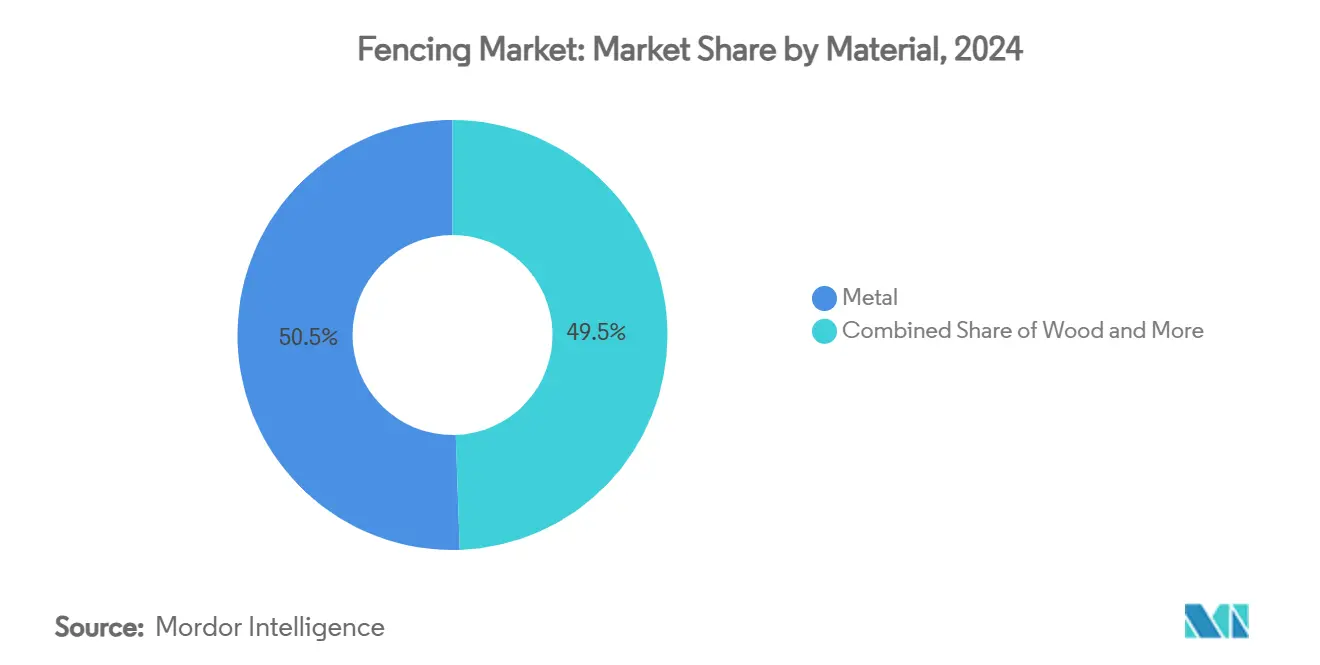
Note: Segment shares of all individual segments available upon report purchase
By End-User: Agricultural Growth Outpaces Residential Leadership
Residential buyers represented 51.7% of 2024 turnover, driven by remodeling cycles and suburban housing starts. Code-compliant pool fences and decorative privacy panels keep volume steady. However, precision agriculture and large-scale solar grazing sites are boosting agricultural demand at a 7.8% CAGR, the quickest among all segments.
Military, government, and critical-infrastructure owners sustain steady mid-single-digit growth as national security programs specify anti-cut mesh and crash-rated vehicle barriers. Data-center and telecom expansions widen the addressable critical-asset base. Mining, petroleum, and chemical operators specify specialty coatings to manage corrosive exposure, while energy utilities integrate perimeter systems into SCADA platforms to create layered security.
Virtual fencing collars paired with lightweight barriers streamline herd rotation, lowering labor bills and reducing soil compaction. Renewable developers co-locating panels and livestock lean on galvanized posts that support both conductors and offset hot-wire deterrents. This dual-purpose model extends the fencing market share of composite suppliers in rural installations.
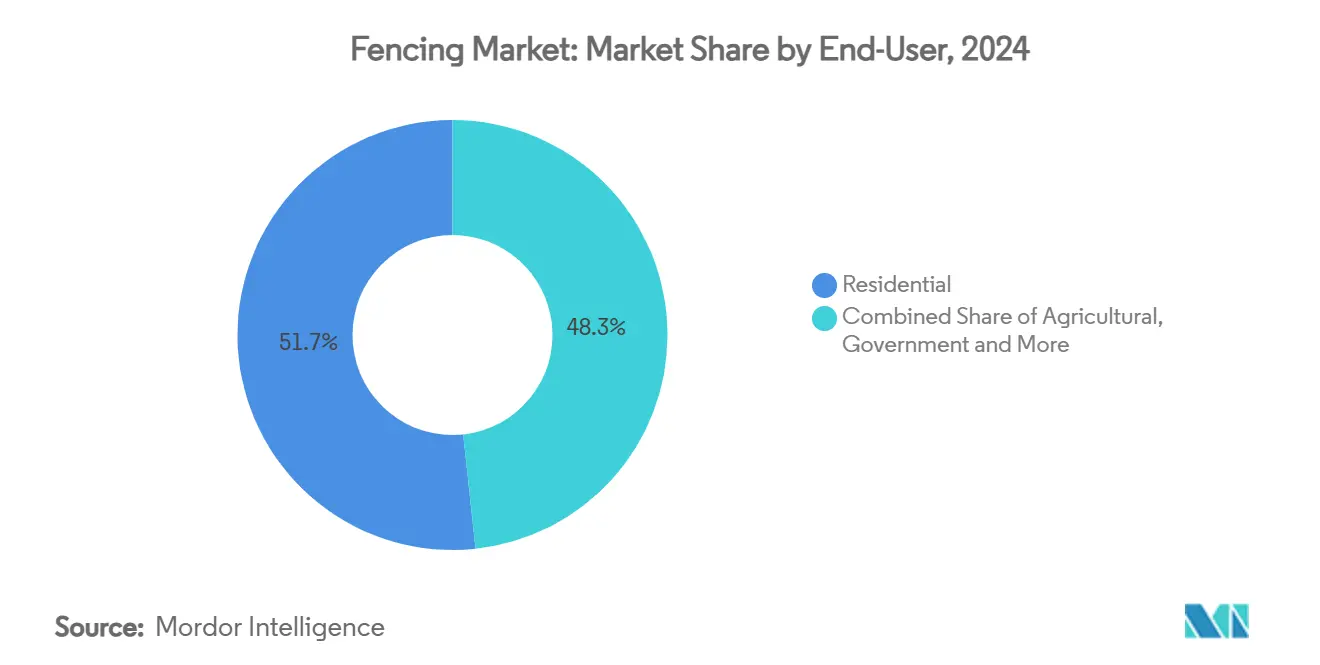
By Installation Type: Professional Services Dominate Despite DIY Growth
Professional contractors delivered 68.43% of 2024 revenue, reflecting stringent permit requirements, warranty obligations, and the complexity of IoT deployments. Federal and defense jobs necessitate vetted personnel and documented chain-of-custody procedures, cementing established integrators’ roles.
DIY and modular kits, though smaller, are expanding at an 8.02% CAGR as click-lock railings and pre-notched posts simplify assembly. Big-box retailers stock color-matched composite boards and online configurators that auto-size the bill of materials. Fabricators occupy a hybrid niche, machining OEM-supplied mesh into bespoke gates for logistics yards and small utilities that lack in-house engineering.
Consumer willingness to pay for smart-home integrations is catalyzing app-controlled gate latches and solar-charged sensor packages. Nevertheless, integration of those devices into alarm monitoring backbones usually prompts homeowners to hire certified installers for final commissioning.
Geography Analysis
North America accounted for 35.54% of 2024 global sales, propelled by federal grants for road, grid, and veterans facility upgrades. Updated NERC rules obligate utilities to fortify substation perimeters, while Buy-America provisions steer spend toward domestic roll-formers and fabricators. An expanding residential remodeling base supports the region’s near-term outlook.
Asia-Pacific, though smaller today, is set to post the fastest 7.43% CAGR through 2030. India has budgeted more than USD 400 million for border fencing, including anti-climb steel grating along high-risk corridors. China’s infrastructure stimulus and urban renewal projects cushion fencing demand despite property-sector headwinds. Japan and South Korea champion smart-sensor adoption, while Australia’s mining sector continues to procure temporary barriers for remote camps.
Europe’s market is framed by stringent eco-design laws and circular-economy targets. Lead-free PVC deadlines and the 2026 EU formaldehyde threshold spur material substitution, opening a competitiveness gap for innovators. Renewables build-out, particularly onshore wind repowering, sustains utility demand. Eastern Europe benefits from EU cohesion fund grants channelled into transport corridors that require long miles of acoustic and security fencing.

Note: Segments share of all individual segments available upon report purchase
Competitive Landscape
The Fencing Market remains moderately fragmented, yet mounting compliance and technology hurdles are nudging it toward tighter concentration. Large vertically integrated producers leverage in-house wire-drawing, coating, and post-processing to control quality and shorten lead times. Bekaert’s 2024 results underline the resilience of cost-efficient manufacturing even under top-line pressure.
Partnerships between traditional hardware vendors and security-software firms are multiplying. Trex’s distribution agreement with Weyerhaeuser widens retail access to composite railing, aiming to double share in a USD 3.3 billion addressable niche. WillScot Mobile Mini’s purchase of McGrath RentCorp expands turnkey site-solution offerings, including modular fencing for construction and industrial events.
IoT-native entrants market subscription models that wrap hardware, intrusion analytics, and maintenance into unified service tiers. Government procurement cycles remain conservative, but pilot projects at small municipal utilities indicate growing acceptance of managed solutions. Certification requirements for cyber-secure device firmware create hurdles that thin out smaller challengers.
Fencing Industry Leaders
-
CertainTeed
-
PLY Gem
-
Bekaert
-
BetaFence
-
Ameristar Perimeter Security
- *Disclaimer: Major Players sorted in no particular order
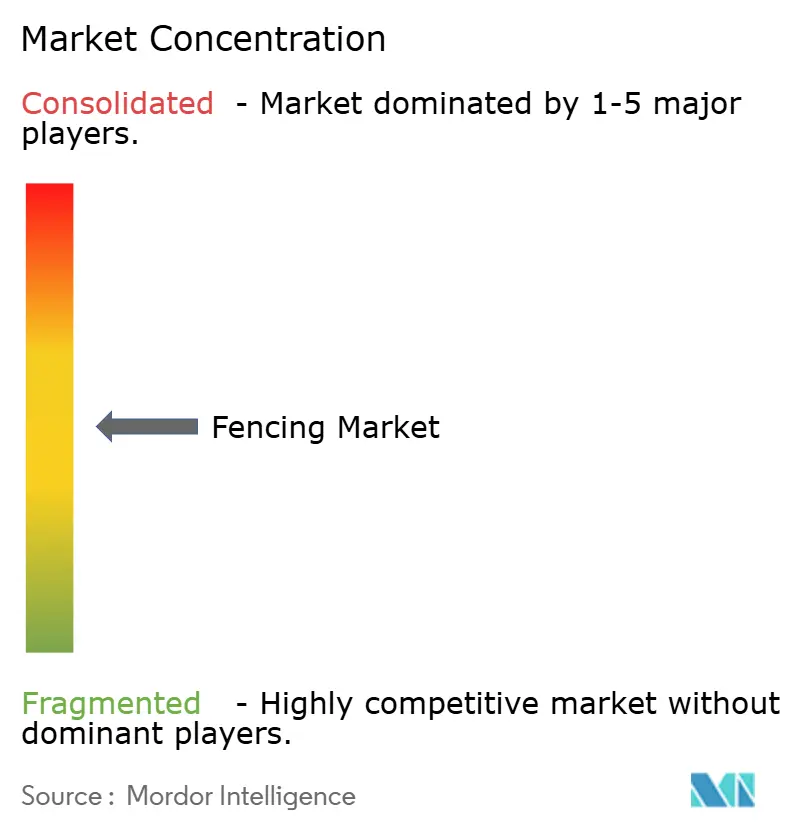
Recent Industry Developments
- February 2025: Bekaert reported EUR 4.0 billion (USD 4.712 billion) in 2024 sales, held EBIT margins stable, and proposed a 6% dividend increase to EUR 1.90 per share (USD 2.24 per share).
- December 2024: Trex Company partnered with Weyerhaeuser to boost the distribution of decking and railing lines across four U.S. states.
- November 2024: EU Regulation 923/2023 capping lead content in PVC entered into force.
- August 2024: Fraunhofer WKI launched the REAC-H-CHO certification to support compliance with EU formaldehyde caps for wood panels.
Global Fencing Market Report Scope
A fence is an artificially constructed barrier of any material or combination of materials erected to enclose or screen areas of land. A complete background analysis of the fencing market, including the assessment of the economy and contribution of sectors in the economy, a market overview, market size estimation for key segments, emerging trends in the market segments, market dynamics and geographical trends, and COVID-19 impact, is covered in the report.
The fencing market is segmented by type (wood fencing, metal fencing, and other types), end user (residential, agricultural, military and defense, government, petroleum and chemicals, mining, energy and power, warehouse, and other end users), and geography (North America, Latin America, Europe, Asia-Pacific, and Middle East and Africa).
The report offers global fencing market size and forecasts in value (USD) for all the above segments.
| Metal | Steel |
| Aluminium | |
| Wood | |
| Plastic & Composite | |
| Concrete | |
| Other Materials |
| Residential |
| Agricultural |
| Military & Defense |
| Government |
| Mining |
| Petroleum & Chemicals |
| Energy & Power |
| Other End-Users |
| Professional Contractor |
| Others - Fabricators, DIY / Modular Kits |
| North America | United States |
| Canada | |
| Mexico | |
| South America | Brazil |
| Argentina | |
| Chile | |
| Rest of South America | |
| Europe | United Kingdom |
| Germany | |
| France | |
| Italy | |
| Spain | |
| Netherlands | |
| Rest of Europe | |
| Middle East and Africa | Saudi Arabia |
| United Arab Emirates | |
| South Africa | |
| Nigeria | |
| Rest of Middle East and Africa | |
| Asia-Pacific | China |
| India | |
| Japan | |
| South Korea | |
| Australia | |
| Indonesia | |
| Rest of Asia-Pacific |
| By Material | Metal | Steel |
| Aluminium | ||
| Wood | ||
| Plastic & Composite | ||
| Concrete | ||
| Other Materials | ||
| By End-User | Residential | |
| Agricultural | ||
| Military & Defense | ||
| Government | ||
| Mining | ||
| Petroleum & Chemicals | ||
| Energy & Power | ||
| Other End-Users | ||
| By Installation Type | Professional Contractor | |
| Others - Fabricators, DIY / Modular Kits | ||
| By Geography | North America | United States |
| Canada | ||
| Mexico | ||
| South America | Brazil | |
| Argentina | ||
| Chile | ||
| Rest of South America | ||
| Europe | United Kingdom | |
| Germany | ||
| France | ||
| Italy | ||
| Spain | ||
| Netherlands | ||
| Rest of Europe | ||
| Middle East and Africa | Saudi Arabia | |
| United Arab Emirates | ||
| South Africa | ||
| Nigeria | ||
| Rest of Middle East and Africa | ||
| Asia-Pacific | China | |
| India | ||
| Japan | ||
| South Korea | ||
| Australia | ||
| Indonesia | ||
| Rest of Asia-Pacific | ||
Key Questions Answered in the Report
What is the current value of the fencing market?
The fencing market stands at USD 36.77 billion in 2025.
How fast is the fencing market expected to grow?
It is projected to register a 6.8% CAGR and reach USD 51.09 billion by 2030.
Which region leads the fencing market today?
CertainTeed, PLY Gem, Bekaert, BetaFence and Ameristar Perimeter Security are the major companies operating in the Fencing Market.
Which is the fastest growing region in Fencing Market?
North America leads with 35.54% of 2024 revenue, underpinned by federal infrastructure spending.
Which material segment is growing the fastest?
Plastic and composite fencing is advancing at an 8.7% CAGR through 2030.
Why is agricultural demand rising so quickly?
Precision farming and agrivoltaic installations are driving agricultural fencing needs at a 7.8% CAGR by integrating security with renewable-energy structures.
How are regulations influencing material choices?
EU rules that cap lead in PVC and limit formaldehyde emissions in wood are pushing manufacturers toward zinc-stabilised PVC and composite alternatives, reshaping supply chains.
Page last updated on:
